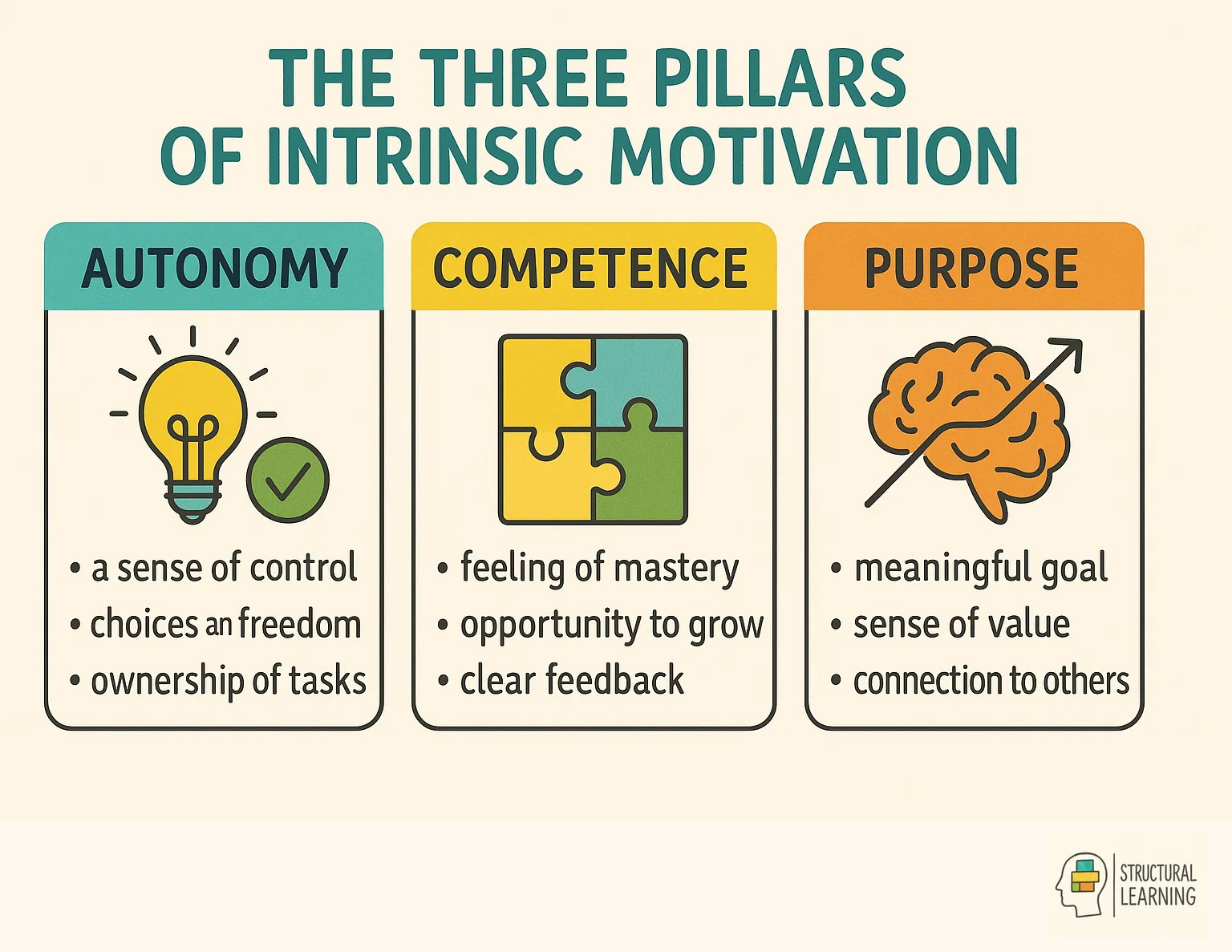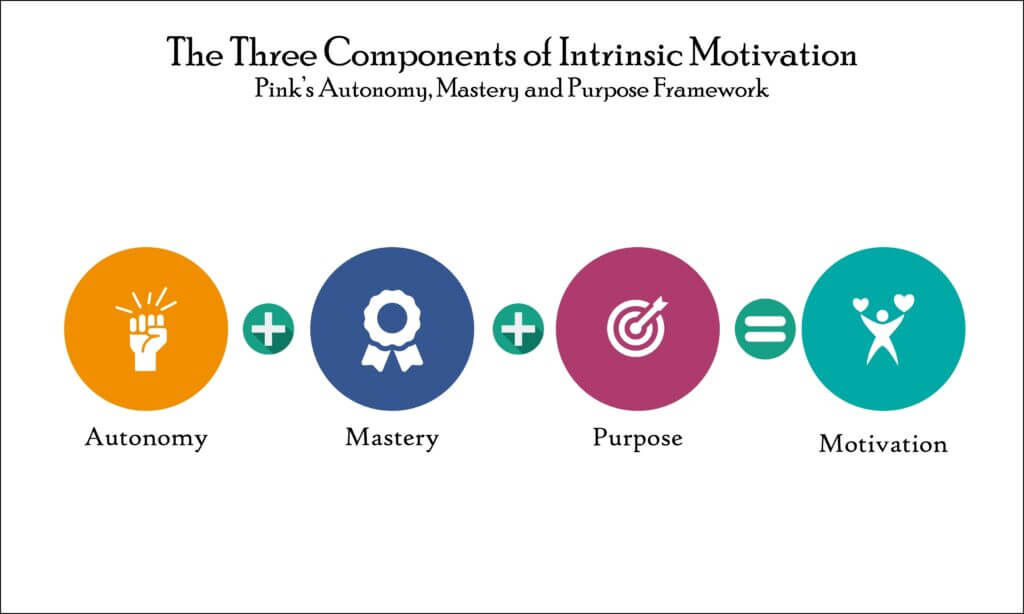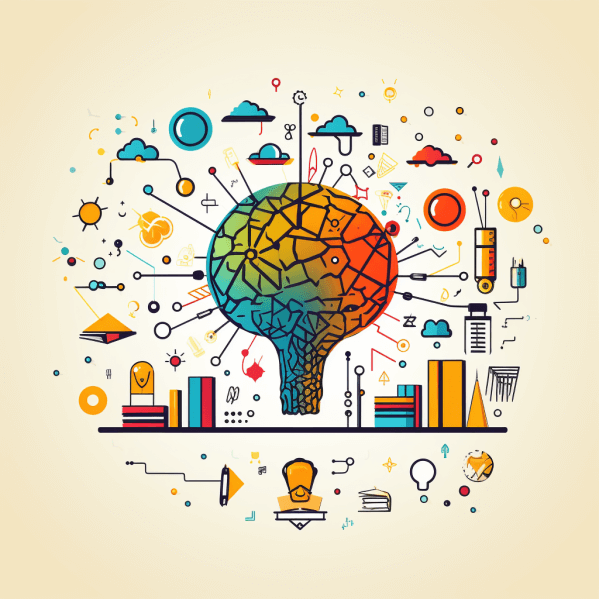Intrinsic Motivation
Discover the psychology behind intrinsic motivation and its impact on learning. Gain insights and strategies to foster self-driven engagement in your classroom.


Discover the psychology behind intrinsic motivation and its impact on learning. Gain insights and strategies to foster self-driven engagement in your classroom.
Intrinsic motivation is a fascinating psychological construct that goes beyond the surface-level understanding of what drives us to act. It's not about the external rewards or the proverbial carrot on a stick; it's about the deep-seated, internal rewards that fuel our very essence.
Think of it as the psychological 'nitro-boost' that propels us into a state of flow, where time dissipates and we're engrossed in the task at hand. This is the realm where optimal levels of performance and creativity reside.

Intrinsic factors are the unsung heroes behind our most motivated behaviors. They're the catalysts for our exploratory activities, whether it's diving into a new book, painting a canvas, or solving a complex mathematical equation.
These are activities we engage in not because someone is watching or because there's a prize at the end, but because they fulfill us in a way that's deeply personal and profoundly satisfying.
Flow theory, pioneered by Mihaly Csikszentmihalyi, offers a compelling framework for understanding this phenomenon. It posits that when we align our tasks with our skills and interests, we enter a 'flow' state, characterized by heightened focus and enjoyment.
This is where intrinsic motivation factors come into play, acting as the internal compass guiding us toward activities that not only challenge us but also provide a sense of accomplishment and joy.
So, as we delve deeper into the psychology, strategies, and background reading on intrinsic motivation, remember that this isn't just academic jargon. It's a roadmap to a more engaged, fulfilling life, both personally and professionally. According to research, understanding and leveraging intrinsic motivation can lead to improved learning, performance, and well-being.
Key Insights:
Intrinsic motivation stems from three core psychological needs: autonomy (control over actions), competence (mastery of skills), and relatedness (connection to others). When these needs are met, individuals experience internal satisfaction that drives behavior without external rewards. The brain releases dopamine during intrinsically motivated activities, creating a natural reward cycle that reinforces engagement.
In the realm of psychology, the study of intrinsic motivation has been a subject of fascination for decades. The seminal work by Edward Deci in the early 1970s laid the foundation, challenging the traditional behaviorist view that external rewards were the primary drivers of human behavior.
Deci's research, published in the Journal of Personality and Social Psychology, introduced the concept of "locus of causality," emphasizing that internal motivation could be just as potent as external motivation.
Fast forward to the 1980s, and we find Richard Ryan collaborating with Deci to further refine and expand upon these ideas. Their work, often cited as Ryan & Deci, led to the development of Self-Determination Theory, a framework that has been instrumental in understanding the complexities of human motivation.
Published by Oxford University Press and Cambridge University Press, their research delved into the concept of "optimal incongruities," suggesting that the right level of challenge could boost motivation and engagement.
The exploratory drive in humans, a term that gained traction in the academic circles, was also examined in the context of intrinsic motivation. A study by J. Comp at Lund University, for instance, looked at how behavior with rewards that are internally satisfying could be more sustainable than those driven by extrinsic factors.
The field has also been enriched by . Publications like Neuroscience Research on Human Motivation have started to unravel the neural mechanisms that underlie intrinsic motivation, adding another layer of complexity to our understanding.
In a world that often emphasizes tangible rewards, the research on intrinsic motivation serves as a compelling counter-narrative. It's not just about the external carrots and sticks; it's about understanding the intricate web of internal drives that propel us forward.
Key Insights:

Key factors include task difficulty matching skill level, meaningful choice in learning activities, and clear connections to personal interests or goals. Environmental factors like classroom atmosphere, peer relationships, and teacher feedback style significantly impact internal drive. Removing controlling language and excessive evaluation pressure while increasing opportunities for self-direction enhances intrinsic motivation.
Intrinsic motivation is fueled by various elements that contribute to internal motivation. These factors play a crucial role in enhancing individuals' drive and enthusiasm for engaging in activities. Let's explore some key elements that influence intrinsic motivation.
1. Challenge and Flow: One of the most compelling factors that drive intrinsic motivation is the concept of challenge. When tasks hit that sweet spot, neither too easy nor too hard, individuals enter a state of flow.
This is where skills and challenges are in perfect harmony, leading to an optimal level of engagement. Empirical studies have shown that this state of flow is a catalyst for enhanced learning and active learning.
2. Control and Autonomy: Control is not just about wielding power; it's about having the autonomy to make decisions that align with one's values and interests.
This sense of control is a cornerstone in building intrinsic motivation. It allows individuals to navigate the target activity with a sense of purpose, thereby fueling their internal drive in learning.
3. Cooperation and Social Relatedness: The power of cooperation and collaboration cannot be overstated when it comes to intrinsic motivation. Engaging in activities that require teamwork fosters a sense of relatedness and belongingness.
This social component enhances intrinsic rewards and stands in contrast to extrinsic rewards, which often focus on individual achievement.

4. Curiosity and Exploratory Behaviors: Curiosity might have killed the cat, but it certainly fuels intrinsic motivation. When individuals are curious, they engage in exploratory behaviors, seeking out new knowledge and experiences.
This natural desire to discover and learn is often more motivating than any external motivation or extrinsic incentives.
5. Recognition and Feedback: While intrinsic motivation is fueled by internal factors, the role of recognition and feedback can't be ignored.
Positive feedback boosts self-esteem and reinforces intrinsic motivation, while negative feedback, if constructive, can also be a learning opportunity. Future studies may delve deeper into how different types of feedback influence intrinsic motivation.
To summarise, intrinsic motivation is a complex interplay of factors like challenge, control, cooperation, curiosity, and recognition. By understanding and nurturing these elements, we can create an environment that not only enhances learning but also fosters a greater sense of satisfaction and fulfillment.

Self-Determination Theory identifies autonomy, competence, and relatedness as the three pillars that fuel intrinsic motivation in learning environments. When students feel they have choice (autonomy), can succeed at appropriately challenging tasks (competence), and belong in their learning community (relatedness), internal motivation flourishes. Teachers support this by offering options, scaffolding success, and building positive classroom relationships.
Self-determination theory is a framework that explores the factors that drive human motivation and behavior. It postulates that individuals have three essential psychological needs: autonomy, competence, and relatedness, which play a crucial role in motivating performance.
Autonomy refers to the need for individuals to feel a sense of control over their actions and decisions. When people have the freedom to make choices and pursue their goals in line with their values and interests, their intrinsic motivation is enhanced.
Autonomy supports a sense of ownership and personal agency, empowering individuals to engage in activities with enthusiasm and commitment.
Competence encompasses the need for individuals to feel capable and effective in their endeavors. When individuals perceive that they have the necessary skills and resources to succeed in a particular activity, it fuels their intrinsic motivation. Developing and refining one's skills and experiencing a sense of mastery nurtures a sense of competence, fostering intrinsic motivation.
Relatedness refers to the need for individuals to feel connected to others and have a sense of belongingness.
Engaging in activities that involve teamwork, cooperation, and social interaction contributes to intrinsic motivation. When individuals feel understood, supported, and accepted by others, their intrinsic motivation is bolstered.
Self-determination theory defines a continuum between intrinsic and extrinsic motivation. Intrinsic motivation arises from internal factors, such as enjoyment, curiosity, and personal satisfaction, while extrinsic motivation stems from external factors, such as rewards, incentives, and goals imposed by others.
Brain imaging shows intrinsic motivation activates the reward centers differently than external rewards, creating more sustainable engagement patterns. The prefrontal cortex and striatum work together during intrinsically motivated tasks, enhancing focus and learning retention. Dopamine release during self-directed activities creates stronger neural pathways than reward-based learning.
The emerging field of neuroscience has provided valuable insights into the nature of intrinsic motivation, shedding light on the underlying neural mechanisms involved. Researchers have traced the history of intrinsic motivation research, comparing and contrasting it to related topics such as flow and curiosity, and linking it to key findings in the comparative affective neurosciences.
Intrinsic motivation has long been associated with the activation of the brain's reward system, particularly the release of dopamine. Dopamine, a neurotransmitter, plays a crucial role in motivating behaviors and promoting a sense of pleasure and reward.
Studies have shown that when individuals engage in intrinsically motivating activities, such as pursuing personal interests and experiencing a state of flow, there is an increase in dopamine levels in the brain.
Neuroscientific research has found that during flow states, coined by Mihaly Csikszentmihalyi, there is a decrease in activity in the prefrontal cortex, which is responsible for self-consciousness and self-evaluation, and an increase in activity in the brain's reward centers.
Curiosity, another intrinsic motivation, has also been a subject of neuroscience research. The SEEKING system in the brain, linked to curiosity and exploration, involves the activation of the mesolimbic dopamine pathway. This pathway is associated with the anticipation of rewards and the pursuit of new and novel experiences.
Overall, the burgeoning neuroscience research on intrinsic motivation has provided valuable insights into the neural correlates of motivation. By understanding the involvement of dopamine and patterns of activity across large-scale neural networks, researchers are gaining a better understanding of how intrinsic motivation shapes behavior and drives individuals towards exploration, flow, and personal growth.
Curiosity acts as a natural intrinsic motivator by creating information gaps that students feel compelled to fill through exploration and learning. When teachers present puzzles, mysteries, or surprising facts, the brain's reward system activates before any answer is found. This curiosity-driven engagement leads to deeper processing and better retention than externally motivated learning.
Curiosity plays a pivotal role in intrinsic motivation as it fuels the desire to explore, seek new knowledge, and engage in active learning. It is a natural inclination that propels individuals to question, discover, and understand the world around them.
When curiosity is sparked, it stimulates the brain's reward system, particularly the release of dopamine.
By engaging the brain's reward centers, curiosity promotes active learning. When individuals are curious, they actively seek out information, test hypotheses, and engage in problem-solving. This active involvement in the learning process enhances understanding and retention of knowledge.
Additionally, curiosity promotes cognitive flexibility, allowing individuals to approach situations from different perspectives and think critically.
Nurturing and encouraging curiosity in educational settings is crucial for fostering intrinsic motivation. Teachers can create an environment that encourages questioning and exploration, providing opportunities for students to pursue their interests and engage in hands-on activities.
Incorporating real-world examples, interactive learning experiences, and open-ended assignments can ignite curiosity and enhance motivation to learn.
In conclusion, curiosity plays a vital role in intrinsic motivation by fueling the desire to explore, seek new knowledge, and engage in active learning.
By understanding and leveraging the power of curiosity, educators can create an environment that fosters intrinsic motivation and maximizes students' learning potential.

Intrinsic motivation comes from internal satisfaction and enjoyment of the activity itself, while extrinsic motivation relies on external rewards like grades, prizes, or praise. Research shows intrinsic motivation leads to better long-term retention, creativity, and well-being compared to external rewards. Overusing extrinsic rewards can actually decrease intrinsic motivation, a phenomenon called the overjustification effect.
Intrinsic and extrinsic motivation are two distinct forms of motivation that drive human behavior. While both types can influence our actions, they differ in their underlying factors and the effects they have on individuals.
Intrinsic motivation refers to the internal desire and enjoyment derived from engaging in an activity. It is driven by the inherent satisfaction, curiosity, or interest in the activity itself. On the other hand, extrinsic motivation arises from external factors such as rewards, incentives, or consequences. It involves engaging in an activity to achieve some external outcome or avoid punishment.
One key difference between intrinsic and extrinsic motivation is the locus of motivation. Intrinsic motivation is self-determined, meaning individuals engage in activities out of their own volition and interest. In contrast, extrinsic motivation is driven by external incentives or pressures, where individuals may feel obligated or coerced to engage in certain activities.
Moreover, intrinsic motivation tends to be more sustainable over time compared to extrinsic motivation. When individuals are intrinsically motivated, they engage in an activity for its own sake, leading to increased effort, persistence, and enjoyment. Extrinsic motivation, while effective in the short term, may decrease intrinsic motivation over time and lead to a reliance on external rewards to sustain engagement.
The impact of extrinsic rewards on intrinsic motivation has been extensively studied. While rewards can initially enhance motivation and performance, they often come with unintended consequences. The provision of tangible rewards for an intrinsically motivating activity can undermine the underlying intrinsic motivation. This is known as the "overjustification effect," where individuals come to attribute their motivation solely to the external rewards rather than personal interest.
In contrast, positive feedback has been found to enhance intrinsic motivation. When individuals receive genuine praise, recognition, or encouragement for their efforts, it fosters a sense of competence, autonomy, and relatedness. Positive feedback contributes to individuals perceiving their internal drive and abilities as valuable and leads to increased intrinsic motivation.
In summary, intrinsic motivation arises from internal factors and the inherent satisfaction of engaging in an activity, while extrinsic motivation is driven by external rewards or pressures. While extrinsic motivation can have short-term benefits, it may undermine intrinsic motivation over time.
Conversely, positive feedback can enhance intrinsic motivation. Understanding the dynamics and impact of these two types of motivation can help create environments that nurture intrinsic motivation while leveraging appropriate extrinsic motivators.

Teachers can foster intrinsic motivation by providing meaningful choices, calibrating challenge levels to match student skills, and emphasizing learning progress over performance outcomes. Effective strategies include using open-ended projects, encouraging student questions, and creating opportunities for peer collaboration. Minimizing controlling language and replacing rewards with informational feedback helps maintain students' natural curiosity and engagement.
By weaving these strategies into your teaching fabric, you're not just promoting intrinsic motivation; you're setting the stage for a transformative educational experience.
Key Insights:

Essential reading includes 'Drive' by Daniel Pink for practical applications, 'Flow' by Mihaly Csikszentmihalyi for understanding optimal experience, and Edward Deci's research on Self-Determination Theory. Academic journals like Contemporary Educational Psychology and Motivation and Emotion publish current research on classroom applications. The Self-Determination Theory website offers free resources and assessment tools for educators.
If you're interested in digging deeper into this field, these studies explore the concept of intrinsic motivation in educational settings.
1. Chaudhuri, J. (2020). "Stimulating Intrinsic Motivation in Millennial Students: A New Generation, a New Approach." Anatomical Sciences Education.
Summary: The study suggests that Millennial students respond well to teaching approaches that stimulate intrinsic motivation, emphasizing the need for a generational shift in teaching methods.
2. Baldassarre, G., Stafford, T., Mirolli, M., Redgrave, P., Ryan, R., & Barto, A. (2014). "Intrinsic motivations and open-ended development in animals, humans, and robots: an overview." Frontiers in Psychology.
Summary: This research provides an overview of how intrinsic motivations contribute to open-ended development in animals, humans, and even robots, highlighting the universality of intrinsic motivation.
3. Cerasoli, C. P., Nicklin, J. M., & Ford, M. (2014). "Intrinsic motivation and extrinsic incentives jointly predict performance: a 40-year meta-analysis." Psychological Bulletin.
Summary: The meta-analysis found that intrinsic motivation and extrinsic incentives are not mutually exclusive and can jointly contribute to performance across various domains.
4. Lepper, M., Henderlong, J., & Gingras, I. (1999). "Understanding the effects of extrinsic rewards on intrinsic motivation--uses and abuses of meta-analysis." Psychological Bulletin.
Summary: This study critically examines the literature on how extrinsic rewards affect intrinsic motivation, cautioning against the misuse of meta-analysis in drawing conclusions.
5. Howard, J. L., Chong, J. X. Y., & Bureau, J. S. (2020). "The tripartite model of intrinsic motivation in education: A 30-year retrospective and meta-analysis." Journal of Personality.
Summary: The meta-analysis reviews 30 years of research on the tripartite model of intrinsic motivation in education, finding that intrinsic motivation remains a significant factor in educational settings.
Intrinsic motivation is a fascinating psychological construct that goes beyond the surface-level understanding of what drives us to act. It's not about the external rewards or the proverbial carrot on a stick; it's about the deep-seated, internal rewards that fuel our very essence.
Think of it as the psychological 'nitro-boost' that propels us into a state of flow, where time dissipates and we're engrossed in the task at hand. This is the realm where optimal levels of performance and creativity reside.

Intrinsic factors are the unsung heroes behind our most motivated behaviors. They're the catalysts for our exploratory activities, whether it's diving into a new book, painting a canvas, or solving a complex mathematical equation.
These are activities we engage in not because someone is watching or because there's a prize at the end, but because they fulfill us in a way that's deeply personal and profoundly satisfying.
Flow theory, pioneered by Mihaly Csikszentmihalyi, offers a compelling framework for understanding this phenomenon. It posits that when we align our tasks with our skills and interests, we enter a 'flow' state, characterized by heightened focus and enjoyment.
This is where intrinsic motivation factors come into play, acting as the internal compass guiding us toward activities that not only challenge us but also provide a sense of accomplishment and joy.
So, as we delve deeper into the psychology, strategies, and background reading on intrinsic motivation, remember that this isn't just academic jargon. It's a roadmap to a more engaged, fulfilling life, both personally and professionally. According to research, understanding and leveraging intrinsic motivation can lead to improved learning, performance, and well-being.
Key Insights:
Intrinsic motivation stems from three core psychological needs: autonomy (control over actions), competence (mastery of skills), and relatedness (connection to others). When these needs are met, individuals experience internal satisfaction that drives behavior without external rewards. The brain releases dopamine during intrinsically motivated activities, creating a natural reward cycle that reinforces engagement.
In the realm of psychology, the study of intrinsic motivation has been a subject of fascination for decades. The seminal work by Edward Deci in the early 1970s laid the foundation, challenging the traditional behaviorist view that external rewards were the primary drivers of human behavior.
Deci's research, published in the Journal of Personality and Social Psychology, introduced the concept of "locus of causality," emphasizing that internal motivation could be just as potent as external motivation.
Fast forward to the 1980s, and we find Richard Ryan collaborating with Deci to further refine and expand upon these ideas. Their work, often cited as Ryan & Deci, led to the development of Self-Determination Theory, a framework that has been instrumental in understanding the complexities of human motivation.
Published by Oxford University Press and Cambridge University Press, their research delved into the concept of "optimal incongruities," suggesting that the right level of challenge could boost motivation and engagement.
The exploratory drive in humans, a term that gained traction in the academic circles, was also examined in the context of intrinsic motivation. A study by J. Comp at Lund University, for instance, looked at how behavior with rewards that are internally satisfying could be more sustainable than those driven by extrinsic factors.
The field has also been enriched by . Publications like Neuroscience Research on Human Motivation have started to unravel the neural mechanisms that underlie intrinsic motivation, adding another layer of complexity to our understanding.
In a world that often emphasizes tangible rewards, the research on intrinsic motivation serves as a compelling counter-narrative. It's not just about the external carrots and sticks; it's about understanding the intricate web of internal drives that propel us forward.
Key Insights:

Key factors include task difficulty matching skill level, meaningful choice in learning activities, and clear connections to personal interests or goals. Environmental factors like classroom atmosphere, peer relationships, and teacher feedback style significantly impact internal drive. Removing controlling language and excessive evaluation pressure while increasing opportunities for self-direction enhances intrinsic motivation.
Intrinsic motivation is fueled by various elements that contribute to internal motivation. These factors play a crucial role in enhancing individuals' drive and enthusiasm for engaging in activities. Let's explore some key elements that influence intrinsic motivation.
1. Challenge and Flow: One of the most compelling factors that drive intrinsic motivation is the concept of challenge. When tasks hit that sweet spot, neither too easy nor too hard, individuals enter a state of flow.
This is where skills and challenges are in perfect harmony, leading to an optimal level of engagement. Empirical studies have shown that this state of flow is a catalyst for enhanced learning and active learning.
2. Control and Autonomy: Control is not just about wielding power; it's about having the autonomy to make decisions that align with one's values and interests.
This sense of control is a cornerstone in building intrinsic motivation. It allows individuals to navigate the target activity with a sense of purpose, thereby fueling their internal drive in learning.
3. Cooperation and Social Relatedness: The power of cooperation and collaboration cannot be overstated when it comes to intrinsic motivation. Engaging in activities that require teamwork fosters a sense of relatedness and belongingness.
This social component enhances intrinsic rewards and stands in contrast to extrinsic rewards, which often focus on individual achievement.

4. Curiosity and Exploratory Behaviors: Curiosity might have killed the cat, but it certainly fuels intrinsic motivation. When individuals are curious, they engage in exploratory behaviors, seeking out new knowledge and experiences.
This natural desire to discover and learn is often more motivating than any external motivation or extrinsic incentives.
5. Recognition and Feedback: While intrinsic motivation is fueled by internal factors, the role of recognition and feedback can't be ignored.
Positive feedback boosts self-esteem and reinforces intrinsic motivation, while negative feedback, if constructive, can also be a learning opportunity. Future studies may delve deeper into how different types of feedback influence intrinsic motivation.
To summarise, intrinsic motivation is a complex interplay of factors like challenge, control, cooperation, curiosity, and recognition. By understanding and nurturing these elements, we can create an environment that not only enhances learning but also fosters a greater sense of satisfaction and fulfillment.

Self-Determination Theory identifies autonomy, competence, and relatedness as the three pillars that fuel intrinsic motivation in learning environments. When students feel they have choice (autonomy), can succeed at appropriately challenging tasks (competence), and belong in their learning community (relatedness), internal motivation flourishes. Teachers support this by offering options, scaffolding success, and building positive classroom relationships.
Self-determination theory is a framework that explores the factors that drive human motivation and behavior. It postulates that individuals have three essential psychological needs: autonomy, competence, and relatedness, which play a crucial role in motivating performance.
Autonomy refers to the need for individuals to feel a sense of control over their actions and decisions. When people have the freedom to make choices and pursue their goals in line with their values and interests, their intrinsic motivation is enhanced.
Autonomy supports a sense of ownership and personal agency, empowering individuals to engage in activities with enthusiasm and commitment.
Competence encompasses the need for individuals to feel capable and effective in their endeavors. When individuals perceive that they have the necessary skills and resources to succeed in a particular activity, it fuels their intrinsic motivation. Developing and refining one's skills and experiencing a sense of mastery nurtures a sense of competence, fostering intrinsic motivation.
Relatedness refers to the need for individuals to feel connected to others and have a sense of belongingness.
Engaging in activities that involve teamwork, cooperation, and social interaction contributes to intrinsic motivation. When individuals feel understood, supported, and accepted by others, their intrinsic motivation is bolstered.
Self-determination theory defines a continuum between intrinsic and extrinsic motivation. Intrinsic motivation arises from internal factors, such as enjoyment, curiosity, and personal satisfaction, while extrinsic motivation stems from external factors, such as rewards, incentives, and goals imposed by others.
Brain imaging shows intrinsic motivation activates the reward centers differently than external rewards, creating more sustainable engagement patterns. The prefrontal cortex and striatum work together during intrinsically motivated tasks, enhancing focus and learning retention. Dopamine release during self-directed activities creates stronger neural pathways than reward-based learning.
The emerging field of neuroscience has provided valuable insights into the nature of intrinsic motivation, shedding light on the underlying neural mechanisms involved. Researchers have traced the history of intrinsic motivation research, comparing and contrasting it to related topics such as flow and curiosity, and linking it to key findings in the comparative affective neurosciences.
Intrinsic motivation has long been associated with the activation of the brain's reward system, particularly the release of dopamine. Dopamine, a neurotransmitter, plays a crucial role in motivating behaviors and promoting a sense of pleasure and reward.
Studies have shown that when individuals engage in intrinsically motivating activities, such as pursuing personal interests and experiencing a state of flow, there is an increase in dopamine levels in the brain.
Neuroscientific research has found that during flow states, coined by Mihaly Csikszentmihalyi, there is a decrease in activity in the prefrontal cortex, which is responsible for self-consciousness and self-evaluation, and an increase in activity in the brain's reward centers.
Curiosity, another intrinsic motivation, has also been a subject of neuroscience research. The SEEKING system in the brain, linked to curiosity and exploration, involves the activation of the mesolimbic dopamine pathway. This pathway is associated with the anticipation of rewards and the pursuit of new and novel experiences.
Overall, the burgeoning neuroscience research on intrinsic motivation has provided valuable insights into the neural correlates of motivation. By understanding the involvement of dopamine and patterns of activity across large-scale neural networks, researchers are gaining a better understanding of how intrinsic motivation shapes behavior and drives individuals towards exploration, flow, and personal growth.
Curiosity acts as a natural intrinsic motivator by creating information gaps that students feel compelled to fill through exploration and learning. When teachers present puzzles, mysteries, or surprising facts, the brain's reward system activates before any answer is found. This curiosity-driven engagement leads to deeper processing and better retention than externally motivated learning.
Curiosity plays a pivotal role in intrinsic motivation as it fuels the desire to explore, seek new knowledge, and engage in active learning. It is a natural inclination that propels individuals to question, discover, and understand the world around them.
When curiosity is sparked, it stimulates the brain's reward system, particularly the release of dopamine.
By engaging the brain's reward centers, curiosity promotes active learning. When individuals are curious, they actively seek out information, test hypotheses, and engage in problem-solving. This active involvement in the learning process enhances understanding and retention of knowledge.
Additionally, curiosity promotes cognitive flexibility, allowing individuals to approach situations from different perspectives and think critically.
Nurturing and encouraging curiosity in educational settings is crucial for fostering intrinsic motivation. Teachers can create an environment that encourages questioning and exploration, providing opportunities for students to pursue their interests and engage in hands-on activities.
Incorporating real-world examples, interactive learning experiences, and open-ended assignments can ignite curiosity and enhance motivation to learn.
In conclusion, curiosity plays a vital role in intrinsic motivation by fueling the desire to explore, seek new knowledge, and engage in active learning.
By understanding and leveraging the power of curiosity, educators can create an environment that fosters intrinsic motivation and maximizes students' learning potential.

Intrinsic motivation comes from internal satisfaction and enjoyment of the activity itself, while extrinsic motivation relies on external rewards like grades, prizes, or praise. Research shows intrinsic motivation leads to better long-term retention, creativity, and well-being compared to external rewards. Overusing extrinsic rewards can actually decrease intrinsic motivation, a phenomenon called the overjustification effect.
Intrinsic and extrinsic motivation are two distinct forms of motivation that drive human behavior. While both types can influence our actions, they differ in their underlying factors and the effects they have on individuals.
Intrinsic motivation refers to the internal desire and enjoyment derived from engaging in an activity. It is driven by the inherent satisfaction, curiosity, or interest in the activity itself. On the other hand, extrinsic motivation arises from external factors such as rewards, incentives, or consequences. It involves engaging in an activity to achieve some external outcome or avoid punishment.
One key difference between intrinsic and extrinsic motivation is the locus of motivation. Intrinsic motivation is self-determined, meaning individuals engage in activities out of their own volition and interest. In contrast, extrinsic motivation is driven by external incentives or pressures, where individuals may feel obligated or coerced to engage in certain activities.
Moreover, intrinsic motivation tends to be more sustainable over time compared to extrinsic motivation. When individuals are intrinsically motivated, they engage in an activity for its own sake, leading to increased effort, persistence, and enjoyment. Extrinsic motivation, while effective in the short term, may decrease intrinsic motivation over time and lead to a reliance on external rewards to sustain engagement.
The impact of extrinsic rewards on intrinsic motivation has been extensively studied. While rewards can initially enhance motivation and performance, they often come with unintended consequences. The provision of tangible rewards for an intrinsically motivating activity can undermine the underlying intrinsic motivation. This is known as the "overjustification effect," where individuals come to attribute their motivation solely to the external rewards rather than personal interest.
In contrast, positive feedback has been found to enhance intrinsic motivation. When individuals receive genuine praise, recognition, or encouragement for their efforts, it fosters a sense of competence, autonomy, and relatedness. Positive feedback contributes to individuals perceiving their internal drive and abilities as valuable and leads to increased intrinsic motivation.
In summary, intrinsic motivation arises from internal factors and the inherent satisfaction of engaging in an activity, while extrinsic motivation is driven by external rewards or pressures. While extrinsic motivation can have short-term benefits, it may undermine intrinsic motivation over time.
Conversely, positive feedback can enhance intrinsic motivation. Understanding the dynamics and impact of these two types of motivation can help create environments that nurture intrinsic motivation while leveraging appropriate extrinsic motivators.

Teachers can foster intrinsic motivation by providing meaningful choices, calibrating challenge levels to match student skills, and emphasizing learning progress over performance outcomes. Effective strategies include using open-ended projects, encouraging student questions, and creating opportunities for peer collaboration. Minimizing controlling language and replacing rewards with informational feedback helps maintain students' natural curiosity and engagement.
By weaving these strategies into your teaching fabric, you're not just promoting intrinsic motivation; you're setting the stage for a transformative educational experience.
Key Insights:

Essential reading includes 'Drive' by Daniel Pink for practical applications, 'Flow' by Mihaly Csikszentmihalyi for understanding optimal experience, and Edward Deci's research on Self-Determination Theory. Academic journals like Contemporary Educational Psychology and Motivation and Emotion publish current research on classroom applications. The Self-Determination Theory website offers free resources and assessment tools for educators.
If you're interested in digging deeper into this field, these studies explore the concept of intrinsic motivation in educational settings.
1. Chaudhuri, J. (2020). "Stimulating Intrinsic Motivation in Millennial Students: A New Generation, a New Approach." Anatomical Sciences Education.
Summary: The study suggests that Millennial students respond well to teaching approaches that stimulate intrinsic motivation, emphasizing the need for a generational shift in teaching methods.
2. Baldassarre, G., Stafford, T., Mirolli, M., Redgrave, P., Ryan, R., & Barto, A. (2014). "Intrinsic motivations and open-ended development in animals, humans, and robots: an overview." Frontiers in Psychology.
Summary: This research provides an overview of how intrinsic motivations contribute to open-ended development in animals, humans, and even robots, highlighting the universality of intrinsic motivation.
3. Cerasoli, C. P., Nicklin, J. M., & Ford, M. (2014). "Intrinsic motivation and extrinsic incentives jointly predict performance: a 40-year meta-analysis." Psychological Bulletin.
Summary: The meta-analysis found that intrinsic motivation and extrinsic incentives are not mutually exclusive and can jointly contribute to performance across various domains.
4. Lepper, M., Henderlong, J., & Gingras, I. (1999). "Understanding the effects of extrinsic rewards on intrinsic motivation--uses and abuses of meta-analysis." Psychological Bulletin.
Summary: This study critically examines the literature on how extrinsic rewards affect intrinsic motivation, cautioning against the misuse of meta-analysis in drawing conclusions.
5. Howard, J. L., Chong, J. X. Y., & Bureau, J. S. (2020). "The tripartite model of intrinsic motivation in education: A 30-year retrospective and meta-analysis." Journal of Personality.
Summary: The meta-analysis reviews 30 years of research on the tripartite model of intrinsic motivation in education, finding that intrinsic motivation remains a significant factor in educational settings.